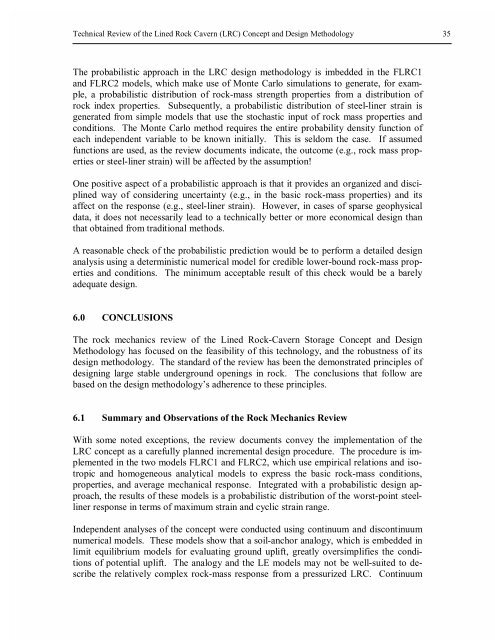Technical Review of the Lined Rock Cavern Concept and Design ...
Technical Review of the Lined Rock Cavern Concept and Design ...
Technical Review of the Lined Rock Cavern Concept and Design ...
You also want an ePaper? Increase the reach of your titles
YUMPU automatically turns print PDFs into web optimized ePapers that Google loves.
<strong>Technical</strong> <strong>Review</strong> <strong>of</strong> <strong>the</strong> <strong>Lined</strong> <strong>Rock</strong> <strong>Cavern</strong> (LRC) <strong>Concept</strong> <strong>and</strong> <strong>Design</strong> Methodology 35<br />
The probabilistic approach in <strong>the</strong> LRC design methodology is imbedded in <strong>the</strong> FLRC1<br />
<strong>and</strong> FLRC2 models, which make use <strong>of</strong> Monte Carlo simulations to generate, for example,<br />
a probabilistic distribution <strong>of</strong> rock-mass strength properties from a distribution <strong>of</strong><br />
rock index properties. Subsequently, a probabilistic distribution <strong>of</strong> steel-liner strain is<br />
generated from simple models that use <strong>the</strong> stochastic input <strong>of</strong> rock mass properties <strong>and</strong><br />
conditions. The Monte Carlo method requires <strong>the</strong> entire probability density function <strong>of</strong><br />
each independent variable to be known initially. This is seldom <strong>the</strong> case. If assumed<br />
functions are used, as <strong>the</strong> review documents indicate, <strong>the</strong> outcome (e.g., rock mass properties<br />
or steel-liner strain) will be affected by <strong>the</strong> assumption!<br />
One positive aspect <strong>of</strong> a probabilistic approach is that it provides an organized <strong>and</strong> disciplined<br />
way <strong>of</strong> considering uncertainty (e.g., in <strong>the</strong> basic rock-mass properties) <strong>and</strong> its<br />
affect on <strong>the</strong> response (e.g., steel-liner strain). However, in cases <strong>of</strong> sparse geophysical<br />
data, it does not necessarily lead to a technically better or more economical design than<br />
that obtained from traditional methods.<br />
A reasonable check <strong>of</strong> <strong>the</strong> probabilistic prediction would be to perform a detailed design<br />
analysis using a deterministic numerical model for credible lower-bound rock-mass properties<br />
<strong>and</strong> conditions. The minimum acceptable result <strong>of</strong> this check would be a barely<br />
adequate design.<br />
6.0 CONCLUSIONS<br />
The rock mechanics review <strong>of</strong> <strong>the</strong> <strong>Lined</strong> <strong>Rock</strong>-<strong>Cavern</strong> Storage <strong>Concept</strong> <strong>and</strong> <strong>Design</strong><br />
Methodology has focused on <strong>the</strong> feasibility <strong>of</strong> this technology, <strong>and</strong> <strong>the</strong> robustness <strong>of</strong> its<br />
design methodology. The st<strong>and</strong>ard <strong>of</strong> <strong>the</strong> review has been <strong>the</strong> demonstrated principles <strong>of</strong><br />
designing large stable underground openings in rock. The conclusions that follow are<br />
based on <strong>the</strong> design methodology’s adherence to <strong>the</strong>se principles.<br />
6.1 Summary <strong>and</strong> Observations <strong>of</strong> <strong>the</strong> <strong>Rock</strong> Mechanics <strong>Review</strong><br />
With some noted exceptions, <strong>the</strong> review documents convey <strong>the</strong> implementation <strong>of</strong> <strong>the</strong><br />
LRC concept as a carefully planned incremental design procedure. The procedure is implemented<br />
in <strong>the</strong> two models FLRC1 <strong>and</strong> FLRC2, which use empirical relations <strong>and</strong> isotropic<br />
<strong>and</strong> homogeneous analytical models to express <strong>the</strong> basic rock-mass conditions,<br />
properties, <strong>and</strong> average mechanical response. Integrated with a probabilistic design approach,<br />
<strong>the</strong> results <strong>of</strong> <strong>the</strong>se models is a probabilistic distribution <strong>of</strong> <strong>the</strong> worst-point steelliner<br />
response in terms <strong>of</strong> maximum strain <strong>and</strong> cyclic strain range.<br />
Independent analyses <strong>of</strong> <strong>the</strong> concept were conducted using continuum <strong>and</strong> discontinuum<br />
numerical models. These models show that a soil-anchor analogy, which is embedded in<br />
limit equilibrium models for evaluating ground uplift, greatly oversimplifies <strong>the</strong> conditions<br />
<strong>of</strong> potential uplift. The analogy <strong>and</strong> <strong>the</strong> LE models may not be well-suited to describe<br />
<strong>the</strong> relatively complex rock-mass response from a pressurized LRC. Continuum

















